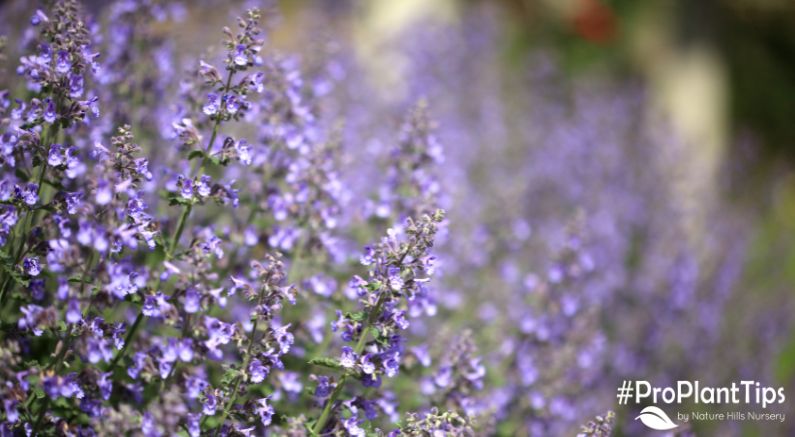Catmints and Catnip are a large group of aromatic Mint family relatives that are very ornamental annuals and perennials in the genus Nepeta!
While truly native to Europe and Asia, these plants have freely naturalized here in the US and become a boon for pollinators galore!
Read on to learn how to use these tough perennials in your garden and how to grow these effortless ornamentals in your Herb gardens, landscaping beds, and container gardens in the sun!
All About Catmint and Catnip

Featuring herbal-scented, fuzzy, scallop-edged, silvery sage-green leaves, these perennials grow quickly! Depending on the variety, Catmint (like its Mint-family relatives) grows into tight-mounded clumps, politely spreading colonies, or even freely naturalizing forms by way of underground rhizomes, stem nodes that can root when they touch the ground, and by seed!
These showy plants send up terminal spires of lavender-blue, white, or pink flowers with two-lipped corollas. The pollinators and beneficial insects will arrive in swarms for these nectar and pollen-rich flower clusters! Even a hummingbird or two will drop by to sip from the tubular florets!
These perennials send up square, erect, and branched stems like the rest of their Mint-family relatives, averaging 1 to 3 feet high. You can pinch back your plants to keep them denser and lower growing.
Flowering throughout the late spring and early summer, with a rebloom that can last until fall, Catnip and Catmint are wonderful scented and aromatic plants from top to bottom!
Calamints
Also in the Mint family, but a different Genus that is closely related to Nepeta is Calamintha, known commonly as Lesser Calamint. A fragrant, low-growing groundcover type plant that has white tubular flowers covering the stems from late spring until frost. Calamint loves those sunny, well-drained soils, easy care, and amazing landscape plants that were the 2021 perennial plant of the year. Check out Lesser Calamints here!
Landscaping & Enjoying Catmint!

Showy mat-forming clumps that can creep and spread when allowed to, or easily kept as tidy mounds, Catmint is a breeze to grow!
These low-water usage plants are great for Rock Gardens, are drought-tolerant plants for Xeric sites, Firewise landscape plans, and equally ideal for pampered Cottage gardens alike!
Use Catmints as spillers and fillers in containers and small gardens as easily as they form mass plantings, filling your landscape or container gardens with their fine-textured, aromatic beauty! Try SylvesterBlue™ Catmint as a bold purple spiller in planters, hanging baskets, and window boxes!
Neptune Catmint will quickly become your favorite bold thriller in mixed planters, or taller Six Hills Giant Catmint as a dramatic back-of-the-border perennial plant or cut flower garden accent!
Walker's Low Catmint shines in the sun with its long spires and tidy clumps that work as focal points in the mixed perennial garden!
The naturalized form of Catnip Plants is a must-have for the pollinator border and creates spreading clumps in your Herb Gardens!

Easy mass plantings that control erosion on hillsides and slopes in the sun, native Catnip can root at each node and spread this way and by way of seeds too! Because of this … you might want to keep an eye on your Catnip plants to prevent them from overstepping.
Use the trimmings to dry for tea in your Tea garden and Victory garden, where the flowers bring in the bees and pollinators that help your veggies and fruiting plants get a pollination boost! You can also dry the leaves and crush them to stuff into your cat toys, as both Catmint and Catnip have a fun effect on your feline friends!
Keeping Catmint Growing Healthy!
Nepeta are wonderfully carefree and easy-to-grow plants, and you will enjoy having them in your garden! Thriving in harsh settings, dry and poor soil locations, are salt-tolerant, and very low maintenance, these plants will shine despite neglect and difficult planting sites!
- Catmint and Catnip are full-sun herbaceous perennials and need at least 6 hours of sun each day. You’ll get the best flowering display and the densest growth this way.
- Grow Nepeta in very fast-draining soil locations or in a raised bed to provide drainage. Any type of soil from rich pampered garden settings to poor sites along the hell strip of a road or sidewalk works for these plants! They will even tolerate some road salt!
- Give these plants a planting hole that is just as deep but a bit wider than their root system, with a 3-4 inch deep layer of mulch over their roots.
- Providing regular water for new installations, not allowing them to dry out between waterings, and watering at the roots using the Finger Test helps ensure proper moisture access.
- Pinch back plants in the early spring to encourage branching and increased blooms while shoring up their size if desired!
- Shearing them after the first round of flowers will keep the overall size in check and quickly push out the next round of long-lasting flowers.
- Prune back plants in the late autumn if you had any foliar issues that year, or wait until early spring in a warmer growing zone, as some of these plants can remain semi-evergreen in mild winters.

Get Your Catnip and Catmint Growing Now!
The aromatic qualities of the Nepeta family come from nepetalactone, which is similar chemically to feline pheromones, triggering a playful, wild response from cats, but has a calming, nervine effect on people! Help promote sleep and calm with a cup of Catmint tea while also acting as a digestive aid.
So bring in the soft, silvery, and scalloped leaves to perfume your garden and enjoy the soft blue and lavender, white, and pink blossoms accenting your landscape! Fun colors and fragrances, add the calming and serene presence of these hardy perennials in your garden, in your containers, and even vase bouquets indoors!
You will find a wide selection of Catnip and Catmint at NatureHills.com and enjoy all the benefits these easy-going perennials have in store for you!
Happy Planting!


